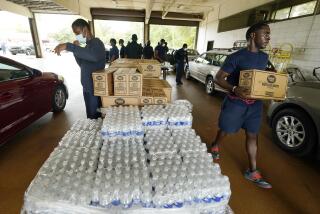REGIONAL REPORT / DROUGHT IN DIXIE : Crops Shriveling as Summer Turns Hot and Rainless : Even the Okefenokee Swamp seems to be drying up. The weather sets off a water war between Alabama, Georgia.
- Share via
WAYCROSS, Ga. — It has been so hot and rainless here this summer that even the Okefenokee Swamp seems to be drying up. At 396,000 acres--most of it in Georgia--the swamp remains one of America’s premier freshwater wetlands, but this year’s absence of rainfall has taken a toll.
Water levels have dropped so much that officials at the Okefenokee Swamp Park say they have had to shorten boat tours from 10 miles to two miles. Rental canoes sit on the dock, unrented in the blazing sun. Lamar Hall, the boat dock manager, wearing a beard and a pith helmet, said he is “hoping for tropical storms. It’ll take a whole lot of rain to bring up the water level.”
Eldean Griffin, another employee, said the alligators that populate the swamp “tend to dig deep holes” in the muck, in search of relief.
What’s bad for the gators is bad for non-gators, too.
Throughout the Southeast this summer, shriveled corn, parched lawns and short tempers have testified to the region’s searing heat and dry skies. Rain has fallen periodically but only as punctuation for the fire-hot season.
The hot, dry weather has damaged soybeans, cotton and tobacco in the Carolinas and Tennessee, as well, according to crop specialists. Milk and egg production has fallen over a wide area, and farmers have been forced to feed their cattle hay that normally is reserved for winter.
All this followed a remarkably soggy spring. Then summer trudged in on dusty feet, lowering water levels and raising fears that the horrendous drought of 1986 may be replayed.
Tommy Irvin, Georgia’s agriculture commissioner, said, “We’ve been burning up here in the Southeast, and it’s getting progressively worse.” So far, he said, the summer heat has “wiped out our non-irrigated corn crop” and much of the state’s alfalfa crop is “totally decimated.”
In Alabama, where spring floods claimed lives, the dry summer is disrupting them. “It’s feast or famine insofar as rainfall has been concerned,” said William Wasden, general counsel to Gov. Guy Hunt. “Who would have known back in March when we had so much rainfall that we would have been encountering these conditions now?”
Amid the dry conditions, water wars have sprung up, with a furious Hunt suing the Army Corps of Engineers in an effort to prevent Georgia from increasing the diversion of water from two rivers flowing into Alabama--the Chattahoochee and the Coosa.
Hunt said he had “done everything in my power to avoid taking legal action” but “to protect Alabama’s right to a reliable water supply, I have no choice but to ask the courts to intervene.”
Barbara Morgan, Georgia Gov. Joe Frank Harris’ spokeswoman, said the governor was “shocked that (Hunt) would take this action when we have been in negotiations” over how much of the water could be diverted.
“I don’t think there’s any way that Alabama has a case here,” said Joseph Goode, a civil engineer with the Corps of Engineers. “It’s hard for me to imagine going up and turning the valves off.”
In metropolitan Atlanta, where a growing population demands ever-increasing amounts of water, myriad outdoor watering restrictions have been devised in municipalities trying to conserve. Violators pay fines or their water lines are disconnected.
Meanwhile, here in the Okefenokee, an Indian term translated as “Land of the Trembling Earth,” tourists continue to slog through the heat, marveling at the swamp, wondering whether it will continue to dry.
Joyce Dowdy, visiting from Knoxville, Tenn., with her husband, Carl, said, “I think it’s fantastic, really beautiful. You don’t see swamps everywhere. It’s the mystery of it.” The same could be said of rain.
More to Read
Sign up for Essential California
The most important California stories and recommendations in your inbox every morning.
You may occasionally receive promotional content from the Los Angeles Times.










